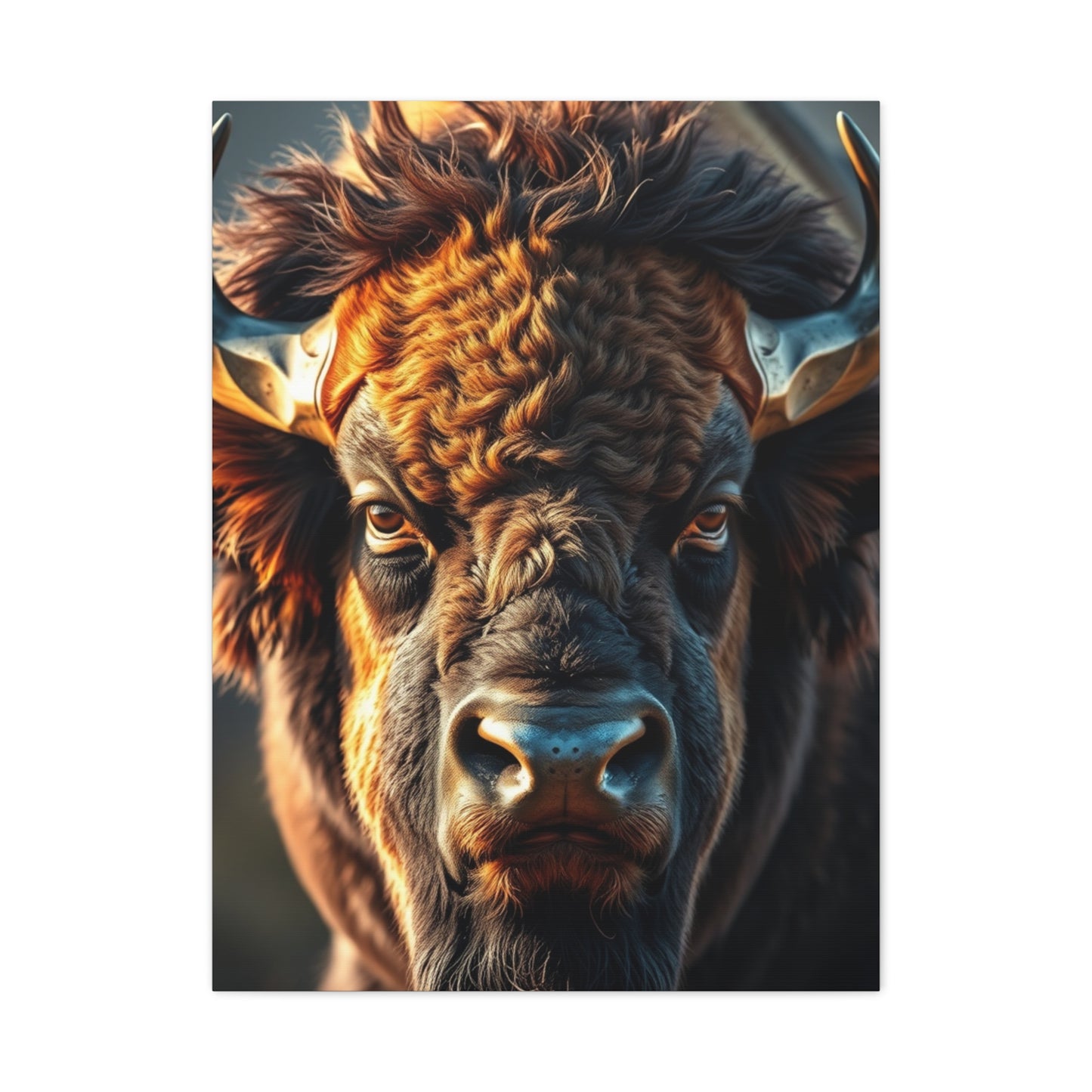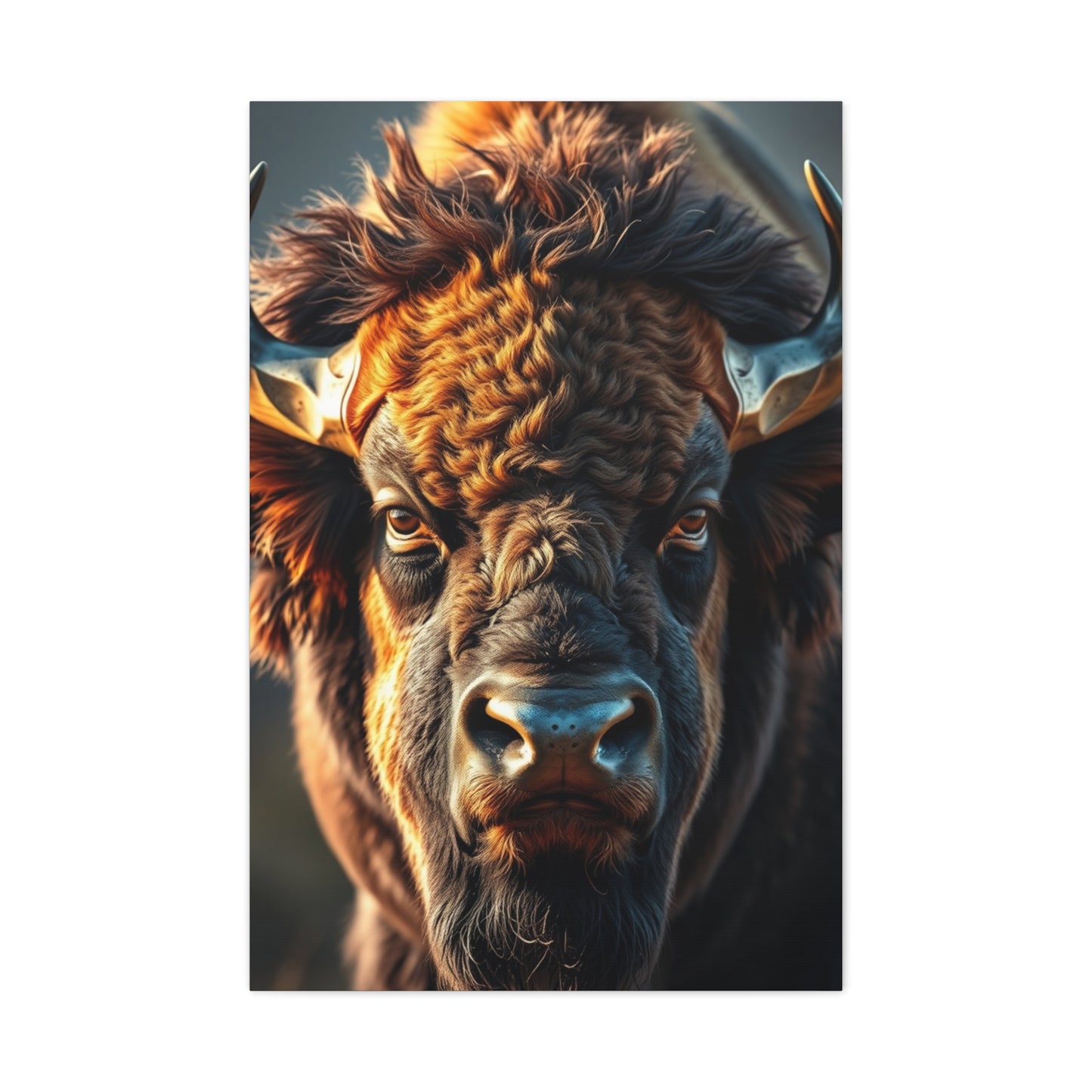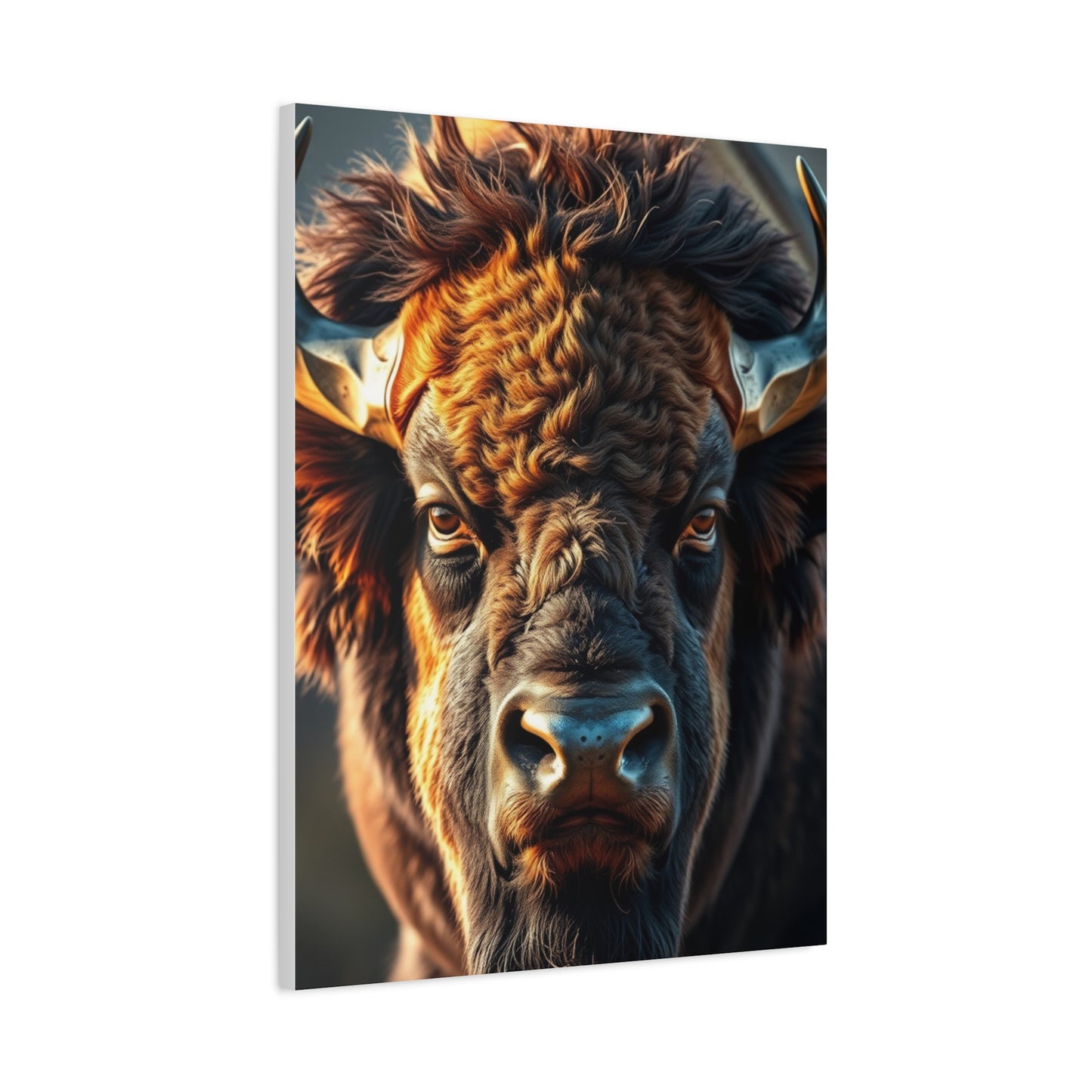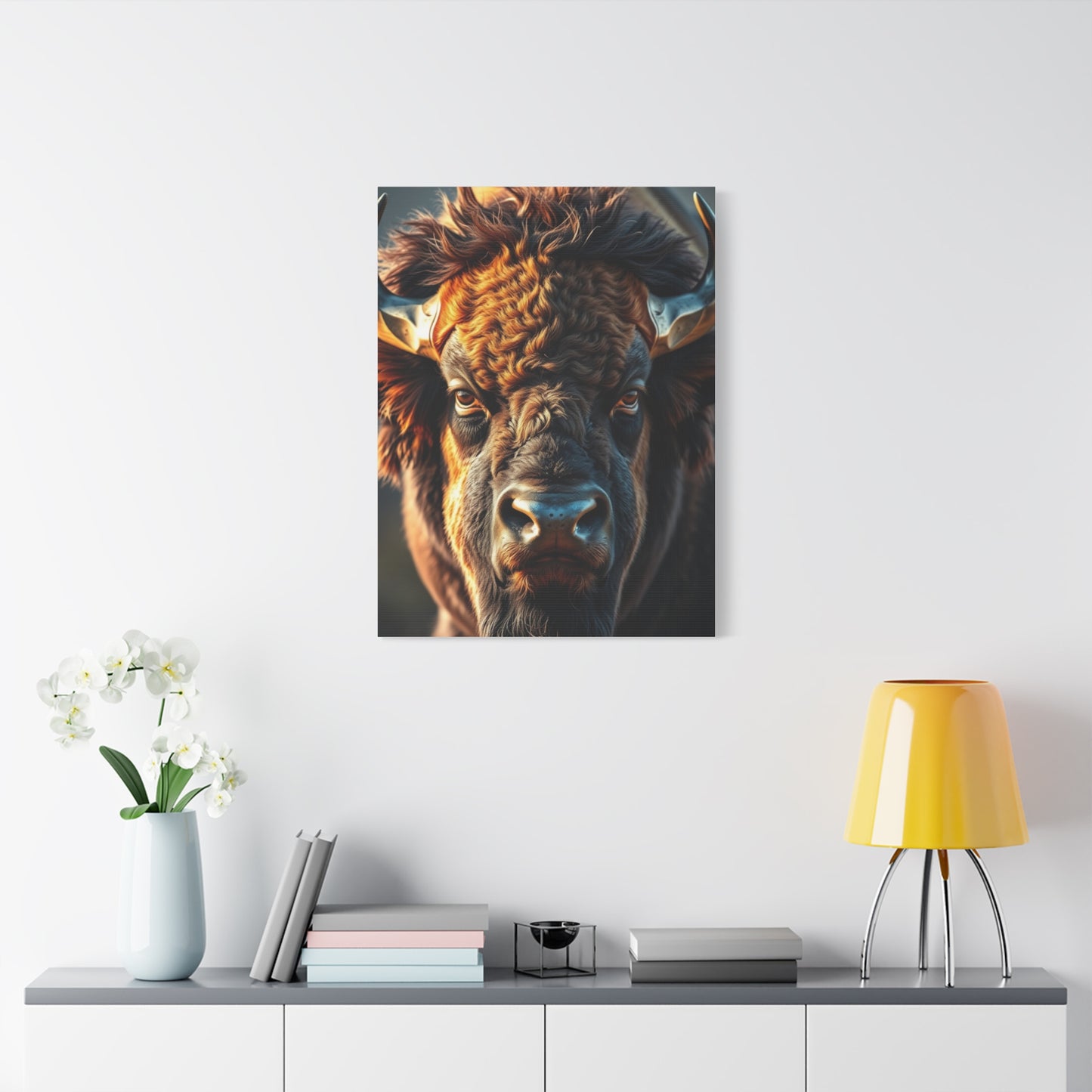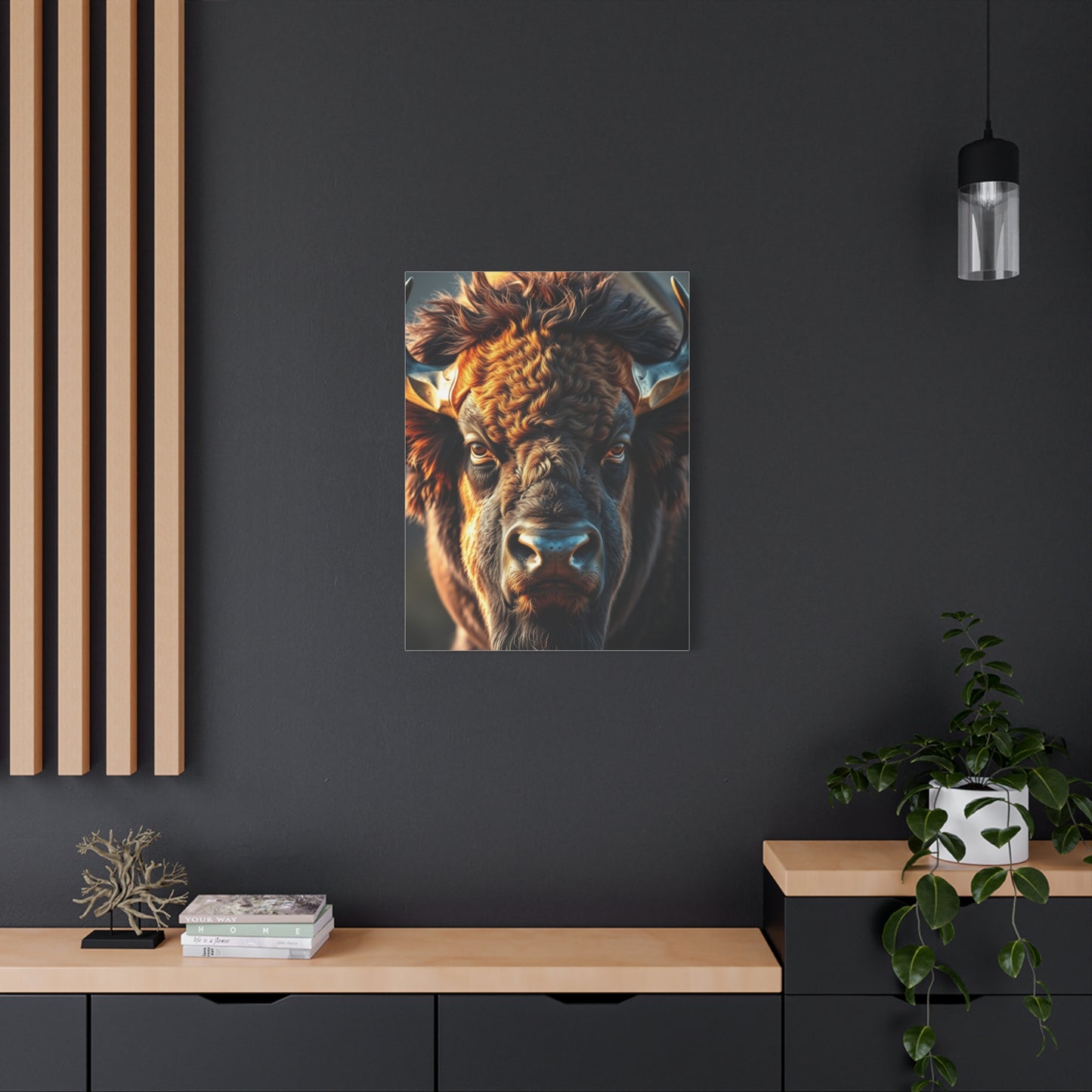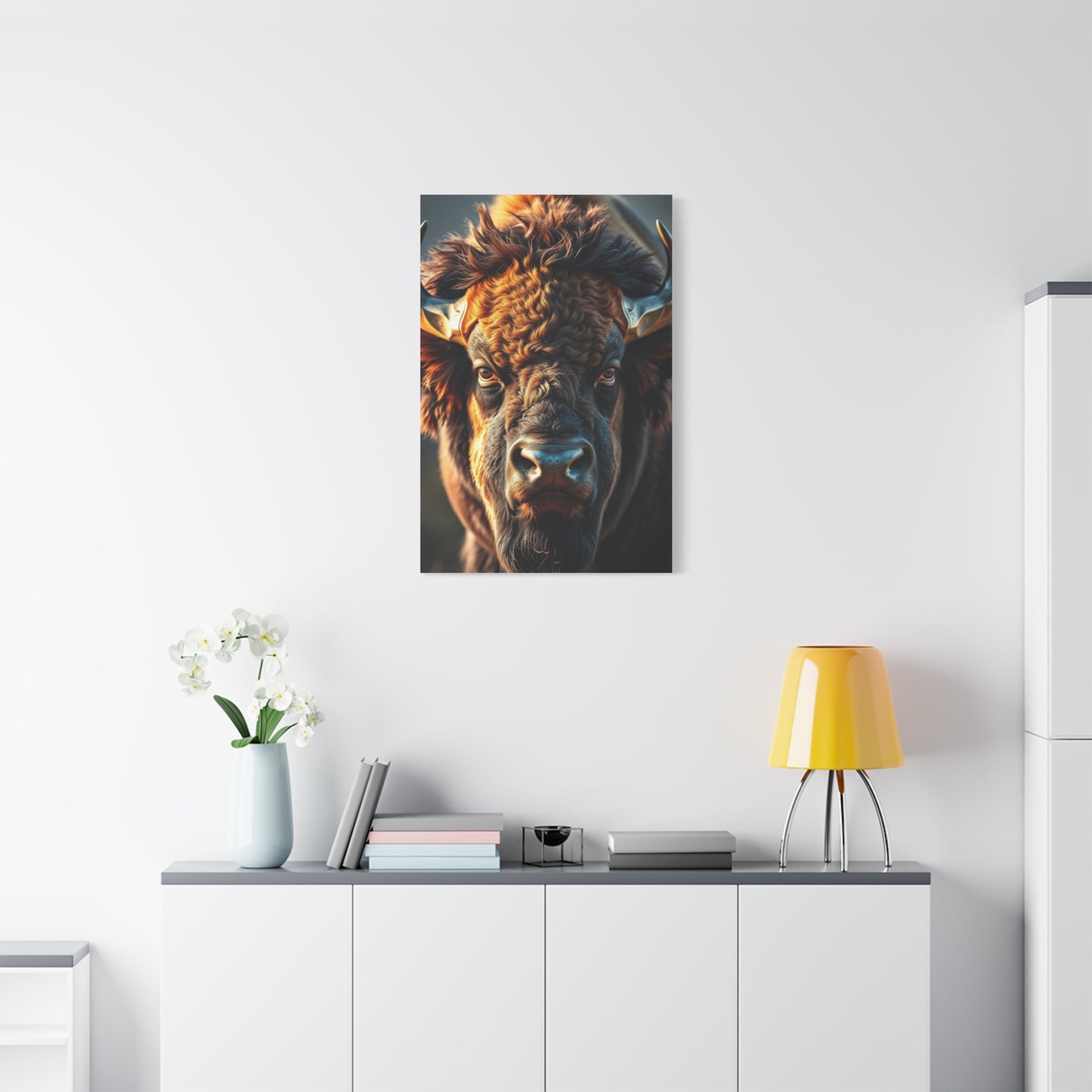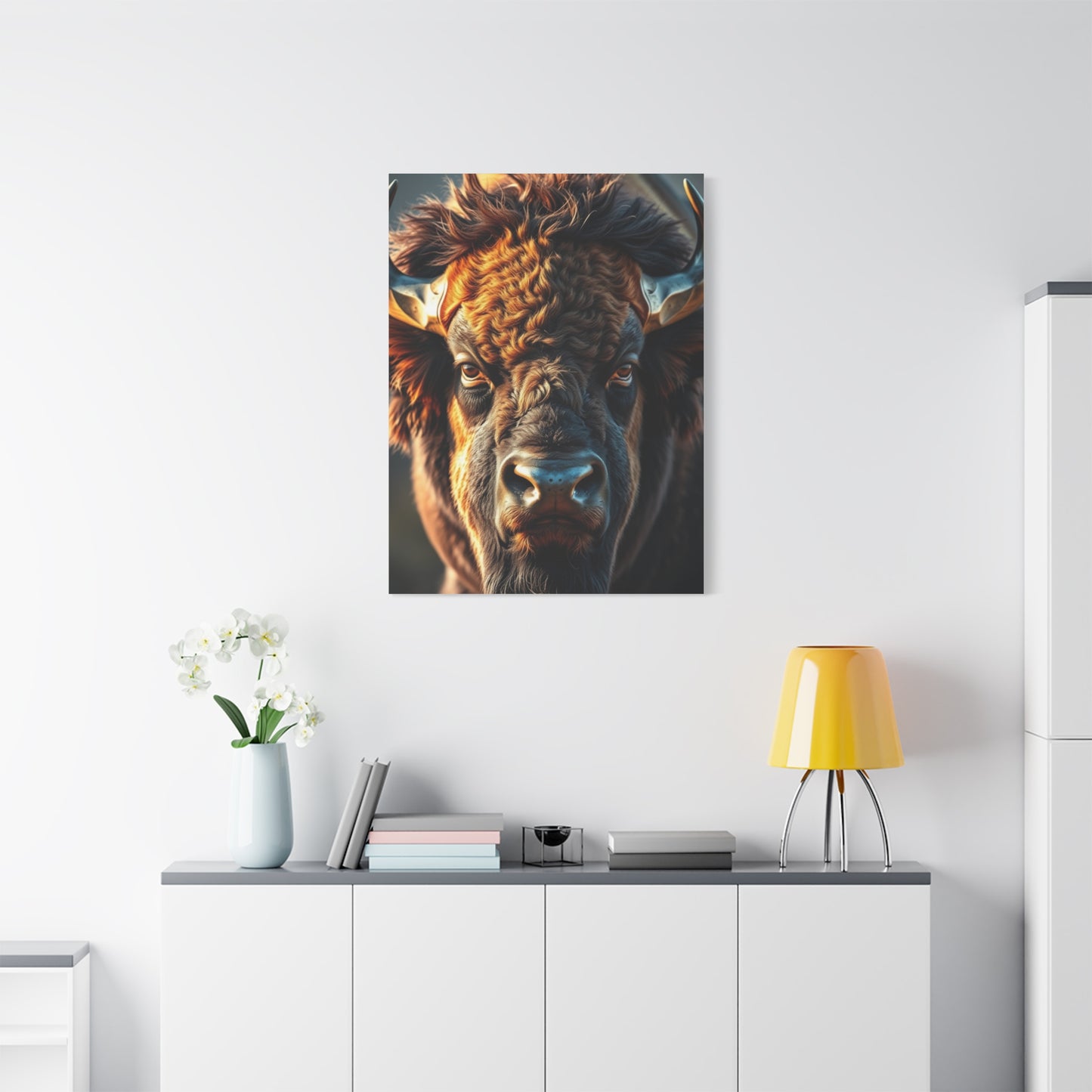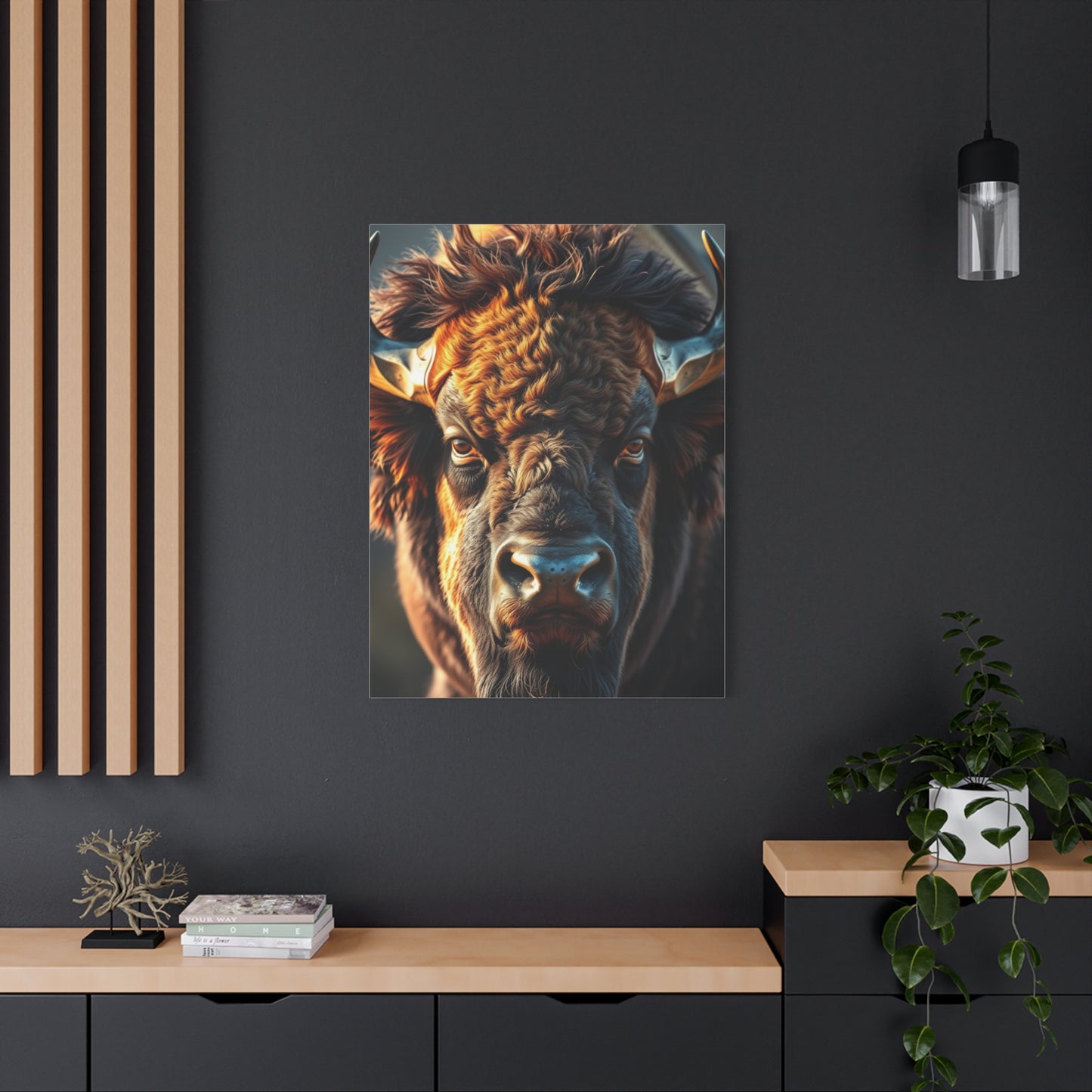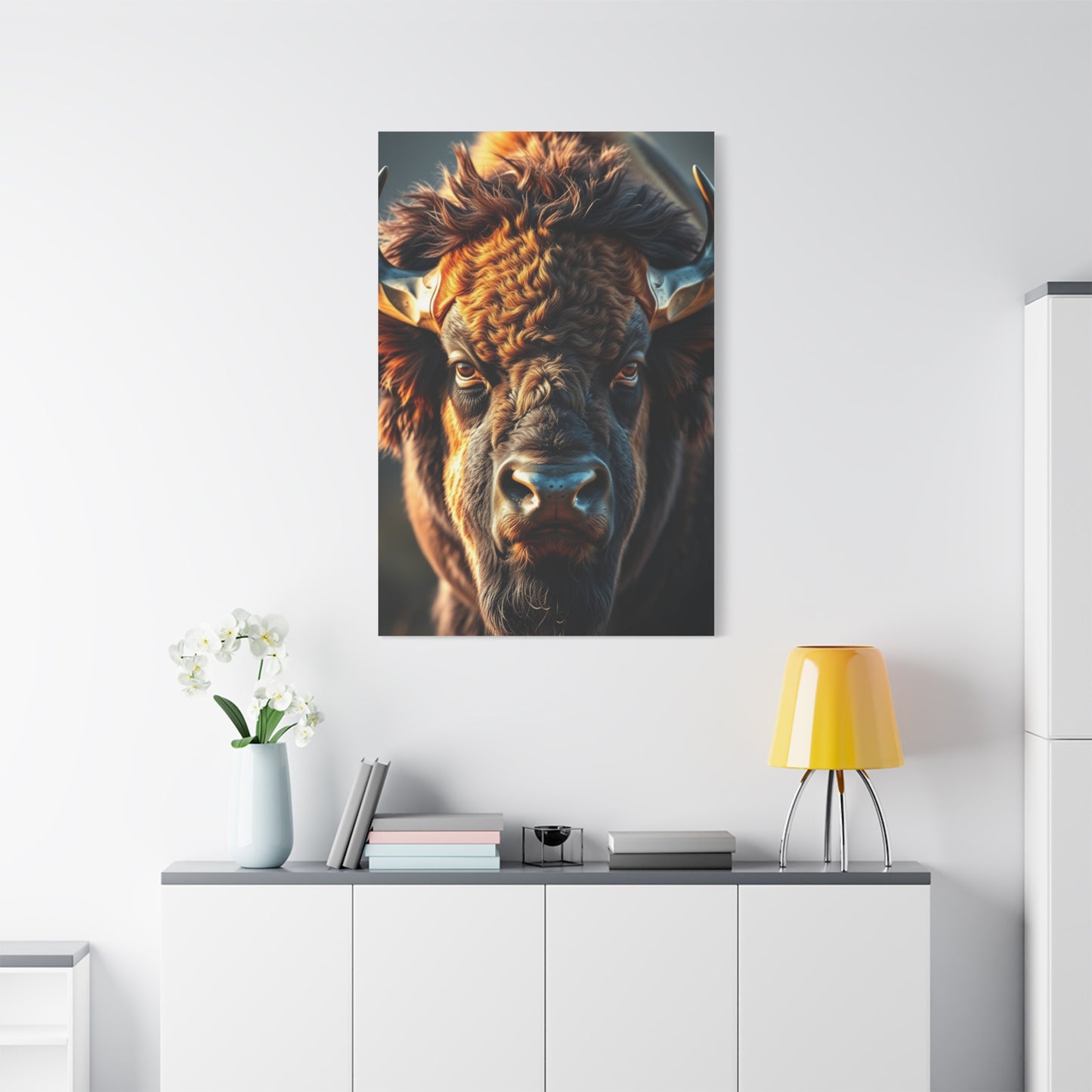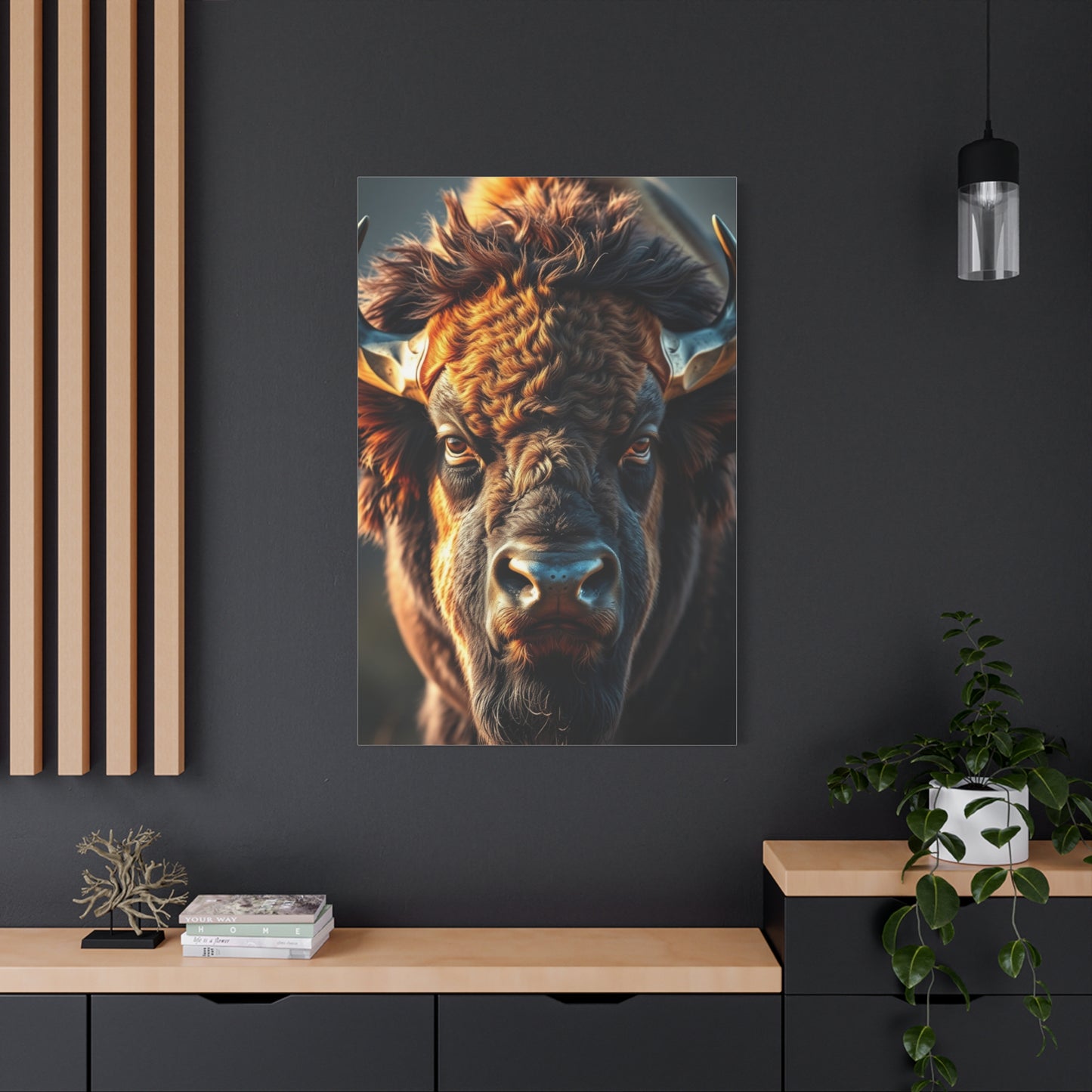The Role of Bison in American Culture: Exploring Their Representation in "Bison Majesty Canvas Wall Art
The profound connection between nature and interior design has evolved dramatically over recent decades, with wildlife-inspired artwork emerging as a powerful tool for creating meaningful, aesthetically compelling spaces. Among the most captivating subjects in this realm stands the American bison, a creature whose physical presence and cultural significance have made it an enduring symbol of strength, resilience, and natural beauty. When captured through the medium of canvas art, the bison transforms from a historical icon into a contemporary design element that speaks to our deepest appreciation for the untamed world. This comprehensive exploration delves into the multifaceted appeal of bison-themed canvas artwork, examining how these pieces function within various design contexts while celebrating the majestic qualities that make them uniquely suited to modern interiors.
Transforming Living Spaces with Wildlife-Inspired Canvas Artwork
The integration of wildlife imagery into residential and commercial environments represents more than a decorative choice; it constitutes a philosophical statement about our relationship with the natural world. Canvas artwork featuring the American bison brings an immediate sense of grandeur and authenticity to any space, creating focal points that command attention without overwhelming surrounding elements. These pieces function as visual anchors, establishing thematic direction for entire rooms while providing conversation-starting centerpieces that reflect the owner's appreciation for nature's most impressive creatures.
The psychological impact of wildlife artwork extends beyond mere aesthetics. Research in environmental psychology suggests that images of natural subjects, particularly powerful animals in their native habitats, can reduce stress levels and promote feelings of connection to the broader ecosystem. When individuals surround themselves with representations of majestic creatures, they create environments that foster contemplation, respect for natural systems, and a sense of perspective regarding humanity's place within the larger web of life. The bison, with its storied history and symbolic weight, carries particular resonance in this regard, serving as a reminder of both the fragility and endurance of wildlife populations.
From a design perspective, wildlife canvas art offers remarkable versatility. Unlike more abstract or contemporary pieces that may clash with traditional elements, bison artwork bridges multiple design philosophies. The organic forms and earthy color palettes associated with these pieces complement rustic interiors while simultaneously providing striking contrast in minimalist or modern settings. This adaptability makes wildlife canvas art an intelligent investment for those who anticipate evolving their interior design over time, as these pieces transition seamlessly between various aesthetic frameworks while maintaining their visual impact and thematic relevance.
The technical execution of canvas artwork plays a crucial role in its effectiveness within interior spaces. High-quality reproductions capture the textural nuances of bison coats, the environmental context of their habitats, and the play of light across landscapes in ways that create depth and dimensionality. These technical considerations elevate artwork from simple decoration to genuine artistic expression, ensuring that pieces maintain visual interest through repeated viewing while contributing substantively to the overall atmosphere of a space. When selecting wildlife canvas art, attention to print quality, color accuracy, and canvas construction ensures longevity and sustained aesthetic value.
Establishing Bold Visual Statements in Contemporary Rooms
Contemporary interior design often struggles with the challenge of creating warmth and character within sleek, minimalist frameworks. The introduction of powerful wildlife imagery provides an elegant solution to this dilemma, injecting personality and emotional resonance into spaces that might otherwise feel austere or impersonal. Canvas artwork featuring the American bison serves this function exceptionally well, as the subject matter carries inherent drama and presence that requires no additional embellishment or stylistic complexity to make an impact.
The scale and composition of bison canvas art significantly influence its effectiveness as a design element. Large-format pieces that showcase these animals in their full majesty create immersive experiences, drawing viewers into the depicted landscapes and establishing immediate emotional connections. These substantial artworks work particularly well in spaces with generous wall area, where they can function as primary focal points around which other design elements orbit. The physical presence of a well-proportioned canvas piece mirrors the impressive stature of the bison itself, creating a harmonious relationship between subject matter and presentation.
Color dynamics within bison artwork offer designers valuable tools for creating cohesive interior schemes. The natural palette associated with these animals ranges from deep, rich browns and blacks to softer tans and creams, while background landscapes may incorporate blues, greens, and warm earth tones depending on seasonal and geographical context. This chromatic variety allows for careful coordination with existing color schemes, whether the goal involves complementary harmonies that enhance visual cohesion or strategic contrasts that create dynamic tension and visual interest. Understanding these color relationships enables more intentional, successful integration of wildlife art into diverse design contexts.
Lighting considerations profoundly affect how canvas artwork functions within a room. The reflective qualities of canvas surfaces, combined with the dimensional nature of quality prints, create opportunities for dramatic lighting effects that transform artwork throughout the day. Natural light reveals subtle details and creates shifting shadows that add life to static images, while strategic artificial lighting can emphasize particular elements, create mood, or ensure the artwork remains visible and impactful during evening hours. Thoughtful illumination design maximizes the investment in quality canvas pieces while contributing to the overall ambiance of the space.
Channeling Power and Resilience Through Animal Imagery
The symbolic dimensions of bison imagery extend deep into American cultural consciousness, representing qualities that resonate across diverse audiences and contexts. These animals embody strength without aggression, community without conformity, and endurance through adversity. When incorporated into interior environments through canvas art, these symbolic associations infuse spaces with intangible qualities that influence how occupants experience and interpret their surroundings. The presence of bison imagery can subtly communicate values, aspirations, and philosophical orientations, making design choices that extend beyond surface aesthetics into more meaningful territory.
Historical connections between bison and indigenous American cultures add layers of significance to artwork featuring these animals. For many Native American nations, the bison represented life itself, providing sustenance, shelter, and spiritual connection. This profound relationship imbues contemporary bison imagery with echoes of respect, gratitude, and acknowledgment of the intricate relationships between humans and the natural world. While appreciation for these cultural dimensions should be approached with appropriate sensitivity and awareness, they nonetheless enrich the experience of living with bison artwork, adding depth and resonance that purely decorative pieces cannot achieve.
The near-extinction and subsequent conservation of American bison populations provides a narrative of redemption and environmental stewardship that aligns with contemporary values around sustainability and ecological responsibility. Displaying bison artwork can serve as a personal statement about environmental commitment, respect for conservation efforts, and recognition of the importance of protecting threatened species and habitats. This connection between aesthetic choices and ethical stances represents an increasingly important dimension of interior design, as individuals seek to align their living environments with their broader values and worldviews.
Psychological research into animal symbolism reveals that exposure to images of powerful, dignified creatures can influence self-perception and behavioral patterns. The qualities associated with bison—steadfastness, resilience, quiet strength—may subtly influence the mindsets of those who regularly encounter these images in their living or working environments. While these effects operate largely at subconscious levels, they contribute to the overall experiential quality of a space, making artwork selection a consideration that extends beyond immediate visual appeal into the realm of environmental psychology and personal development.
Capturing Natural Splendor in Wall-Mounted Canvas Format
The technical artistry involved in creating compelling bison canvas artwork deserves recognition and appreciation. Photographers and digital artists who specialize in wildlife imagery must possess not only technical proficiency but also deep understanding of animal behavior, habitat characteristics, and the patience required to capture truly exceptional moments. The best bison artwork results from countless hours spent in the field, waiting for ideal lighting conditions, optimal compositions, and those fleeting instances when animal subjects display the full range of their character and presence.
Print quality separates mediocre canvas reproductions from pieces that function as legitimate art objects worthy of prominent display. High-resolution source images, advanced printing technologies, and premium canvas materials combine to create reproductions that honor the original photographic or artistic vision. Color fidelity ensures that the rich browns of bison coats, the varied tones of grassland habitats, and the atmospheric qualities of sky and weather conditions translate accurately from digital files to physical canvases. These technical considerations may seem mundane compared to aesthetic discussions, but they fundamentally determine whether artwork enhances or detracts from interior environments.
Canvas as a medium offers distinct advantages for wildlife artwork compared to alternative formats. The texture of canvas surfaces adds dimensionality and tactile interest that flat prints on paper or metal cannot replicate. This textural quality creates subtle interplay with lighting conditions, generating visual dynamism that keeps artwork engaging through repeated viewing. Canvas also conveys a sense of traditional artistic legitimacy, connecting contemporary reproductions to historical painting traditions in ways that elevate their perceived value and appropriateness for serious interior design applications.
Framing and mounting decisions significantly impact how bison canvas art integrates into existing spaces. Gallery-wrapped canvases that extend imagery around frame edges create clean, contemporary presentations that work well in modern interiors, while traditionally framed pieces may better suit more conventional design contexts. Floating frames add depth and shadow play that enhance the three-dimensional qualities of canvas artwork, while frameless presentations maximize the sense of the image extending beyond its physical boundaries. These presentation choices should align with both the specific artwork and the broader design context to ensure cohesive, intentional results.
Establishing Rustic Aesthetic Foundations with Wildlife Art
Rustic interior design draws inspiration from natural materials, traditional craftsmanship, and the unpretentious beauty of rural and wilderness environments. Within this design framework, bison canvas artwork functions as a natural complement, reinforcing thematic coherence while providing visual focal points that anchor other decorative elements. The organic qualities of wildlife imagery harmonize seamlessly with rough-hewn wood, natural stone, leather furnishings, and other materials common in rustic interiors, creating layered, textured environments that feel simultaneously comfortable and visually sophisticated.
The color relationships between bison artwork and rustic design palettes deserve careful consideration. Rustic interiors typically feature warm, earthy tones drawn from natural materials—the honey tones of aged wood, the varied browns and tans of leather and stone, the muted greens of aged copper or patinated metals. Bison imagery naturally incorporates similar colors, creating seamless visual integration that feels organic rather than forced. This chromatic harmony allows wildlife artwork to enhance rather than compete with other design elements, contributing to the overall sense of cohesion that characterizes successful rustic interiors.
Texture plays a crucial role in rustic design, and canvas artwork contributes to this textural richness in subtle but meaningful ways. The woven surface of canvas, the dimensional qualities of quality prints, and the varied textures depicted within the artwork itself—thick fur coats, weathered grasslands, rough bark and stone—all add to the tactile complexity that makes rustic spaces feel inviting and authentic. This textural interplay creates visual interest that operates at multiple scales, from the broad compositional elements visible from across a room to the fine details revealed through closer inspection.
Authenticity represents a core value in rustic design philosophy, distinguishing genuine rustic interiors from theme park caricatures. Bison artwork contributes to this authenticity by representing real animals in actual habitats, grounding the design in tangible reality rather than romanticized fantasy. This connection to genuine wilderness and wildlife history aligns with the rustic emphasis on honest materials and straightforward presentation, creating interior environments that feel true to their inspirational sources rather than derivative or superficial. Selecting artwork that captures the real character of bison and their environments ensures that these pieces support rather than undermine the authentic rustic aesthetic.
Enhancing Nature-Focused Interior Design Schemes
Nature-inspired interior design encompasses a broad spectrum of approaches, from literal representations of outdoor environments to more abstract interpretations of natural principles and aesthetics. Within this expansive framework, bison canvas artwork occupies a specific niche that combines representational accuracy with symbolic and aesthetic power. These pieces function as bridges between indoor and outdoor worlds, bringing elements of wilderness into controlled domestic environments while maintaining the comfort and functionality required of living spaces.
Biophilic design principles, which emphasize human connections to natural systems and living organisms, provide theoretical support for incorporating wildlife artwork into interior environments. Research in this field demonstrates that visual connections to nature—even through representational imagery rather than direct views—can provide measurable psychological and physiological benefits. Bison artwork, with its powerful evocation of wilderness landscapes and charismatic fauna, serves as an effective tool for implementing biophilic design principles in situations where direct natural views or living plants may be impractical or insufficient.
Seasonal considerations influence how nature-inspired artwork functions within interior spaces. Bison imagery often captures specific seasonal moments—winter storms revealing the animals' cold-weather adaptations, spring calving seasons highlighting new life and renewal, summer grazing in lush grasslands, autumn gatherings before winter challenges. Artwork that reflects particular seasons can create dynamic relationships with the changing year, resonating differently as occupants experience corresponding environmental changes outside their walls. This temporal dimension adds depth to the relationship between artwork and viewers, preventing the static quality that sometimes afflicts permanently installed decorative elements.
The integration of bison canvas art within broader nature-inspired design schemes requires attention to thematic coherence and stylistic consistency. Mixing wildlife subjects, landscape imagery, botanical elements, and natural abstractions can create rich, layered environments that celebrate multiple facets of the natural world. However, this mixing requires careful curation to avoid cluttered or confused results. Bison artwork typically functions best as a primary focal point within nature-themed spaces, with supporting elements chosen to complement rather than compete with these powerful central images. Understanding principles of visual hierarchy and compositional balance ensures that multiple nature-inspired elements work together harmoniously rather than fragmenting visual attention.
Optimizing Workspace Environments with Powerful Animal Imagery
Professional environments face unique design challenges, requiring spaces that project appropriate images while supporting productivity, creativity, and wellbeing. Wildlife canvas artwork, particularly pieces featuring impressive subjects like bison, offers valuable solutions to these challenges. In office settings, such artwork communicates qualities like strength, stability, and endurance—attributes that align well with professional aspirations and corporate values. The presence of nature-inspired imagery also helps humanize potentially sterile work environments, creating more comfortable, engaging spaces that support employee satisfaction and performance.
The psychological effects of wildlife imagery in workspaces deserve serious consideration. Studies examining workplace design and productivity consistently identify connections between environmental quality and work outcomes. Natural elements, including representational nature imagery, reduce stress, improve focus, and enhance creative thinking. Bison artwork specifically may trigger associations with determination, resilience, and the ability to weather challenges—mental frameworks that can positively influence how individuals approach difficult tasks or navigate professional obstacles. While these effects may be subtle, their cumulative impact on workplace experience and productivity justifies thoughtful attention to artwork selection.
Reception areas and public spaces within professional environments particularly benefit from powerful wildlife artwork. These transitional zones set initial impressions and communicate organizational character to visitors, clients, and new employees. Bison canvas art in these contexts conveys substance, authenticity, and connection to values beyond immediate commercial concerns. Unlike generic corporate artwork or abstract pieces that could appear in any office anywhere, wildlife imagery with clear regional or cultural connections can communicate specific geographic identities or organizational commitments to environmental stewardship and sustainability.
Home office spaces present distinct opportunities for integrating wildlife canvas artwork into professional environments. As remote and hybrid work arrangements become increasingly common, individuals exercise greater control over their workspace aesthetics while still requiring environments that support professional focus and productivity. Bison artwork in home offices can help mentally separate work zones from purely domestic areas, establishing psychological boundaries that support work-life balance. The presence of powerful natural imagery also provides visual relief during intensive work sessions, offering opportunities for brief mental breaks that can enhance sustained focus and prevent burnout.
Integrating Wildlife Art into Minimalist Contemporary Settings
Minimalist design philosophy emphasizes simplicity, intentionality, and the elimination of unnecessary elements. Within this stripped-down aesthetic framework, each component carries increased significance and must justify its presence through genuine contribution to the space. Wildlife canvas artwork, particularly striking subjects like bison, functions exceptionally well within minimalist contexts precisely because of its inherent power and self-sufficiency. These pieces require no supporting elements or additional embellishment to make their impact, aligning perfectly with minimalist principles while providing the warmth and character that purely architectural minimalism sometimes lacks.
The compositional clarity typical of quality wildlife photography complements minimalist design sensibilities. Well-executed bison artwork features clean compositions with clear subject focus, uncluttered backgrounds, and strong visual geometries that mirror the intentional simplicity prized in minimalist interiors. This aesthetic alignment allows wildlife art to integrate seamlessly into minimalist spaces without introducing the visual complexity or decorative excess that would conflict with the overall design philosophy. The result is a synthesis where powerful natural imagery and refined architectural simplicity enhance rather than compromise each other.
Color discipline represents a crucial consideration when integrating wildlife artwork into minimalist interiors. Minimalist spaces typically feature restricted color palettes with careful attention to tonal relationships and chromatic subtlety. Bison imagery naturally incorporates neutral, earth-based colors that complement minimalist preferences while introducing organic warmth that softens potentially cold architectural environments. Black and white or near-monochromatic bison artwork offers particularly elegant solutions for strictly controlled minimalist palettes, providing visual interest and emotional resonance without chromatic disruption.
Scale relationships between artwork and architectural elements gain heightened importance in minimalist contexts where fewer objects compete for attention. Large-format bison canvas art can anchor minimalist spaces, providing appropriate visual weight to balance expansive walls and open floor plans. Conversely, carefully proportioned smaller pieces can create intimate focal points without overwhelming sparse environments. Understanding these scalar relationships and their psychological impacts ensures that wildlife artwork enhances rather than compromises the carefully calibrated spatial qualities that define successful minimalist design.
Understanding Cultural and Spiritual Significance in Art Selection
The symbolic weight carried by bison imagery extends beyond aesthetic considerations into cultural, historical, and spiritual dimensions that enrich the experience of living with these artworks. For indigenous peoples of the North American plains, bison represented far more than a food source; they embodied fundamental life forces and spiritual connections to the land. While contemporary use of bison imagery in home decor operates in different contexts, awareness of these deeper significances adds layers of meaning and respect to artwork selection and display.
The near-extinction of bison populations during the nineteenth century represents one of the most dramatic ecological catastrophes in American history, with profound implications for both wildlife conservation and indigenous cultures whose ways of life were intimately connected to these animals. Displaying bison artwork can serve as acknowledgment of this history and recognition of ongoing conservation efforts that have brought the species back from the brink of extinction. This historical consciousness transforms decorative choices into meaningful statements about values, environmental awareness, and respect for the complex relationships between human societies and the natural world.
Contemporary conservation of bison populations involves not only biological management but also cultural considerations, particularly regarding the relationships between indigenous nations and these culturally significant animals. Several tribes actively manage bison herds, both for practical purposes and as expressions of cultural continuity and sovereignty. Awareness of these contemporary relationships adds depth to appreciation of bison artwork, connecting aesthetic enjoyment to ongoing stories of cultural survival, environmental restoration, and the complex negotiations between traditional ways of life and modern realities.
Spiritual and meditative practices often incorporate animal symbolism, with bison representing groundedness, strength in community, and the ability to endure hardship while maintaining dignity. For individuals who engage with contemplative practices or seek to cultivate particular qualities in their personal development, bison artwork can serve as visual focal points that support these intentions. While such uses move beyond conventional interior design considerations, they demonstrate the multifaceted ways that thoughtfully selected artwork can function within living spaces, serving practical, aesthetic, and personal development purposes simultaneously.
Developing Distinctive Character Through Strategic Art Placement
Interior spaces often struggle with anonymity, particularly in contemporary residential developments where similar floor plans and standardized finishes create environments lacking individual character. Strategic artwork selection and placement provide powerful tools for differentiating spaces and expressing personal identity through environmental design. Wildlife canvas art featuring bison offers particularly effective solutions to this challenge, as these pieces carry immediate visual impact and clear thematic content that makes strong stylistic statements.
The relationship between artwork and furniture arrangements significantly influences how spaces function and feel. Bison canvas art positioned above sofas, console tables, or other horizontal furniture elements creates natural focal points that organize surrounding areas and direct visual attention. These arrangements benefit from careful attention to proportional relationships, with artwork sized appropriately relative to supporting furniture to create balanced, harmonious compositions. Undersized artwork can appear insignificant or lost, while oversized pieces may overwhelm their contexts, so understanding these scalar relationships proves essential for successful integration.
Architectural features within rooms provide opportunities for strategic artwork placement that enhances both the art and the architecture. Positioning bison canvas art on prominent walls visible from multiple areas creates anchor points that unify open-plan spaces while respecting the flow between functional zones. Artwork placed in relationship to windows, doorways, or other architectural features can create dynamic dialogues between natural and represented landscapes, interior and exterior spaces, or cultivated and wild environments. These thoughtful placement decisions transform artwork from isolated decorative objects into integral components of holistic spatial experiences.
Lighting design profoundly affects how artwork contributes to interior character. Natural light sources create constantly shifting relationships between artwork and its environment, with changing sun angles and weather conditions revealing different aspects of images throughout days and seasons. Supplementary artificial lighting—whether ambient room lighting or dedicated picture lights—ensures artwork remains visible and impactful during evening hours while creating opportunities for dramatic effects that enhance the atmospheric qualities of spaces. These lighting considerations should inform both artwork selection and placement decisions to maximize the investment in quality canvas pieces.
Celebrating American Heritage Through Wildlife Representation
The American bison occupies a unique position in the national consciousness, representing both the magnificence of the continent's original wilderness and the consequences of unchecked exploitation. As an icon of the American frontier and the vast grassland ecosystems that once stretched across the central continent, bison imagery connects contemporary viewers to foundational narratives about exploration, settlement, and the transformation of landscapes. Displaying bison artwork engages with this complex heritage, acknowledging both the grandeur of what once was and the ongoing efforts to preserve remnants of these ecosystems and species.
National park imagery often features bison as central subjects, connecting these animals to beloved public lands and the conservation ethos embodied by the national park system. Artwork depicting bison in recognizable park settings—whether the thermal features of Yellowstone, the dramatic badlands of Theodore Roosevelt National Park, or the prairies of Wind Cave—creates specific geographic connections that resonate with visitors to these areas while communicating broader values about public lands, conservation, and the democratic tradition of preserving natural wonders for public enjoyment and future generations.
Regional identity in areas historically associated with bison populations finds expression through wildlife artwork that celebrates these connections. From the northern plains states and provinces to the southern prairie regions, bison represent historical continuity and geographic distinctiveness. For residents of these areas, displaying bison canvas art serves as an expression of place-based identity and pride in regional heritage. This geographic specificity adds personal significance beyond general nature appreciation, creating emotional connections between individuals, their living spaces, and the landscapes they inhabit or value.
Educational dimensions of bison artwork provide opportunities for engaging visitors and family members with natural history, conservation stories, and ecological principles. Quality wildlife art can spark conversations about animal behavior, ecosystem relationships, historical changes to landscapes and species populations, and contemporary conservation challenges and successes. These educational potentials transform artwork from purely aesthetic objects into tools for learning and engagement, adding functional value to decorative investments while fostering environmental literacy and conservation awareness.
Achieving Visual Harmony with Neutral Color Schemes
Neutral interior palettes dominate contemporary residential design, offering versatility, timelessness, and the ability to accommodate changing furnishings and accessories without requiring wholesale redecoration. Within these neutral frameworks, introducing appropriate accent elements becomes crucial for preventing spaces from feeling bland or characterless. Bison canvas artwork provides ideal solutions to this challenge, as the natural color palettes of these animals and their habitats incorporate rich, complex neutrals that complement and enhance neutral interior schemes while providing necessary visual interest and focal points.
The sophisticated neutrals present in bison imagery extend far beyond simple browns or tans. Careful observation reveals complex color relationships—warm chocolate tones grading into cooler grays, highlights catching golden or amber notes, shadows revealing blue or purple undertones. These nuanced color variations create visual richness that rewards attention while maintaining overall chromatic restraint compatible with neutral interiors. Understanding these subtle color qualities enables more successful artwork selection that truly harmonizes with existing palettes rather than merely avoiding obvious conflicts.
Texture assumes increased importance within neutral color schemes, where chromatic variety cannot provide visual interest and differentiation between surfaces and elements. The textural qualities inherent in bison artwork—the apparent depth of thick winter coats, the varied surfaces of grassland habitats, the play of light across three-dimensional forms—add crucial visual complexity to neutral interiors. When combined with the physical texture of canvas surfaces and the dimensional qualities of quality prints, these textural elements prevent neutral spaces from feeling flat or monotonous despite their chromatic restraint.
Metallic accents commonly appear in neutral interiors, providing subtle luminosity and refined detail that enhances overall sophistication. Bison canvas artwork can incorporate metallic elements through frame choices or matting materials, creating connections between artwork and other metallic details in light fixtures, hardware, or decorative accessories. These coordinated metallic touches unify disparate elements within neutral schemes, creating cohesive visual narratives that tie rooms together despite potentially diverse furniture styles or architectural features.
Selecting Meaningful Presents for Wildlife Enthusiasts
Gift selection presents ongoing challenges, particularly when seeking presents that combine thoughtfulness, lasting value, and genuine alignment with recipient interests and values. For individuals who demonstrate passion for wildlife, conservation, or outdoor experiences, bison canvas artwork represents an exceptionally appropriate gift choice that communicates understanding of their interests while providing lasting aesthetic and emotional value. Unlike consumable gifts or trendy items with limited longevity, quality wildlife artwork becomes a permanent fixture in recipients' living environments, serving as enduring reminders of the giver's thoughtfulness.
Personalization opportunities enhance the gift potential of wildlife canvas artwork. Many providers offer customization options including size selection, framing choices, or even commissioning specific compositions that align with recipient preferences or commemorate particular experiences. A piece depicting bison in a national park the recipient loves, for example, combines wildlife appreciation with personal memory, creating gifts with multiple layers of significance. These personalized touches demonstrate extra thought and effort that elevate gifts beyond generic purchases into truly meaningful gestures.
Occasion appropriateness broadens the utility of wildlife artwork as gifts. Housewarming presents that help new homeowners establish character in their spaces, retirement gifts acknowledging chapters of freedom and personal exploration ahead, milestone celebrations marking significant achievements or life transitions—bison canvas art suits all these contexts while avoiding the potential tackiness or inappropriateness that affects some gift categories. The dignity and power associated with bison imagery ensures that these pieces communicate respect and substance rather than frivolity or thoughtlessness.
Practical considerations support wildlife canvas artwork as gift choices. Unlike furniture or larger decorative items that require specific spatial accommodations or may not suit recipient preferences, appropriately sized canvas art can adapt to various spaces and design contexts. The established cultural acceptance of wildlife artwork across diverse aesthetic preferences reduces the risk of giving a piece that conflicts with recipient tastes. These practical advantages, combined with the emotional and symbolic resonance of bison imagery, make wildlife canvas art a reliable, appreciated gift option for appropriate recipients.
Appreciating Natural Grandeur Through Artistic Representation
The physical presence of American bison never fails to impress those fortunate enough to encounter these animals in their natural habitats. Standing up to six feet tall at the shoulder and weighing up to 2,000 pounds, bison command immediate respect through sheer mass and power. Capturing this imposing physical presence in two-dimensional artwork requires exceptional technical skill and artistic sensibility. The best bison canvas art successfully translates three-dimensional grandeur into compelling images that convey the animals' impressive stature and commanding presence despite the limitations of flat media.
Behavioral qualities captured in wildlife photography add crucial dimensions beyond physical documentation. Bison displaying characteristic behaviors—pawing the ground, wallowing in dust, moving as coordinated herds across open landscapes, enduring harsh weather with stoic determination—these action-oriented images provide insights into animal life beyond static portraiture. Artwork capturing these behavioral moments creates more engaging viewing experiences, as viewers can imagine the sounds, smells, and atmospheric conditions surrounding the depicted scenes. This imaginative engagement transforms passive viewing into active participation, deepening the connection between artwork and audience.
Environmental context significantly influences how wildlife subjects appear in artistic representations. Bison photographed against dramatic weather conditions—snow storms, golden hour light, morning mist, dramatic cloud formations—gain additional impact through the interplay between animal subjects and atmospheric conditions. These environmental elements provide opportunities for artistic expression beyond straightforward documentation, as photographers or artists use weather, light, and landscape to create mood, emphasize particular qualities, or construct compelling compositions that work as cohesive visual statements rather than simple subject recordings.
Seasonal variations in bison appearance and behavior provide diverse artistic opportunities. Winter bison with thick, snow-crusted coats present dramatically different subjects than summer animals in sleek, shedding pelage. Spring calves introduce narrative elements of new life and generational continuity, while autumn gathering behaviors suggest preparation and community. Artwork capturing these seasonal variations offers opportunities for creating series or collections that represent different temporal moments, adding depth and complexity to wildlife art installations while celebrating the cyclical nature of animal life and ecosystem processes.
Maximizing Impact in Spaces with Generous Wall Dimensions
Large wall surfaces present both opportunities and challenges in interior design. Without appropriate focal points, expansive walls can feel empty or institutional, yet incorrectly scaled or positioned elements can appear lost or insignificant. Wildlife canvas artwork, particularly large-format pieces featuring visually powerful subjects like bison, provides ideal solutions for these challenging spaces. The inherent grandeur of bison imagery matches the scale of generous walls, creating proportional relationships that feel balanced and intentional rather than overwhelming or insufficient.
Multi-panel installations offer creative approaches to filling large wall areas while maintaining visual coherence. Triptych or larger panel arrangements depicting different aspects of bison behavior, seasonal variations, or landscape contexts create unified artistic statements that span substantial wall surfaces without the visual weight of single massive images. These multi-panel approaches also provide flexibility for irregular wall configurations or spaces interrupted by architectural features, as individual panels can be arranged to accommodate doors, windows, or other constraints while maintaining overall compositional integrity.
Vertical wall spaces, often more challenging than horizontal expanses, benefit from carefully selected wildlife artwork that emphasizes vertical compositional elements. Images of standing bison, particularly those incorporating vertical landscape features like trees, cliffs, or dramatic sky elements, work effectively in tall, narrow wall areas that might defeat horizontally oriented artwork. Understanding these compositional relationships and their architectural applications enables more successful artwork selection for diverse spatial configurations.
Gallery wall arrangements incorporating wildlife canvas art alongside complementary pieces create dynamic, layered installations appropriate for large wall areas. Combining bison artwork with landscape imagery from similar habitats, smaller wildlife subjects sharing the same ecosystems, or abstract pieces drawing color inspiration from the central wildlife image creates visually rich environments that sustain interest through complexity and variety. These curated arrangements require careful planning regarding spacing, size relationships, and thematic coherence, but when executed successfully, they transform large walls into engaging visual narratives rather than single focal points.
Creating Authentic Atmosphere in Rural and Country Settings
Country homes and rural properties enjoy natural connections to the landscapes and wildlife that inspire bison canvas artwork. In these settings, wildlife imagery functions not as aspirational decoration or urban escape fantasy but as authentic reflection of the surrounding environment and the lifestyle it supports. Bison artwork in country homes acknowledges and celebrates the genuine relationship between residents and the natural world, creating interior environments that echo and complement outdoor surroundings rather than providing contrast or escape from daily reality.
Architectural characteristics common in country homes—exposed beams, stone fireplaces, plank flooring, substantial windows framing rural views—create ideal contexts for wildlife canvas artwork. These rustic architectural elements provide textural and thematic foundations that wildlife imagery naturally complements, building cohesive environments where no element feels incongruous or forced. The honest materials and straightforward construction typical of country architecture aligns philosophically with the unadorned power of quality wildlife photography, creating harmonious relationships between multiple design layers.
Outdoor enthusiasts and landowners who actively engage with wildlife management, habitat conservation, or simply spend substantial time observing and appreciating wild animals develop particular connections to wildlife imagery. For these individuals, bison canvas art serves as more than decoration; it represents shared values, respected qualities, and genuine passion for the subjects depicted. This authentic connection between resident and artwork creates more meaningful relationships than purely aesthetic appreciation, transforming interior design into expression of core identity and values.
Functional spaces in country homes—mudrooms, workshops, studies, or gathering spaces designed for practical use rather than formal entertaining—particularly benefit from wildlife artwork that reinforces the property's rural character. Unlike formal living areas that might demand more restrained or sophisticated artistic choices, these functional spaces welcome bolder, more personality-driven artwork selections. Bison canvas art in these contexts celebrates the rugged, practical qualities associated with rural living while adding visual interest to spaces that might otherwise receive minimal decorative attention.
Introducing Spatial Depth Through Layered Visual Elements
Sophisticated interior design creates the perception of depth and dimensionality even within the two-dimensional constraints of walls and floors. Wildlife canvas artwork contributes to this dimensional illusion through multiple mechanisms. Images depicting bison within expansive landscape contexts naturally incorporate foreground, middle ground, and background elements that suggest spatial recession and three-dimensional relationships. This inherent depth within the artwork itself creates windows into illusory spaces that extend beyond physical wall surfaces, making rooms feel more spacious and complex than their actual dimensions might suggest.
The interplay between artwork and physical space creates additional depth effects. Positioning canvas pieces away from walls through floating frames or mounting systems introduces actual three-dimensional space between artwork and architectural surfaces. This physical separation creates shadow play and visual complexity that enhances the perception of depth while giving artwork greater presence and importance within the room. These mounting strategies, combined with careful lighting design, transform flat wall surfaces into layered, dimensional compositions that add architectural interest and visual sophistication.
Color perspective principles, where warmer colors advance visually while cooler colors recede, operate within wildlife artwork to create depth effects. Bison imagery often features warm browns and tans in foreground subjects while incorporating cooler blues, grays, or muted greens in background landscapes and sky elements. This natural color perspective reinforces spatial recession within images while creating opportunities for intentional color relationships with surrounding interior elements. Understanding these color-depth relationships enables more sophisticated integration of artwork into comprehensive design schemes.
Overlapping elements within compositions create additional depth cues that the human visual system interprets as three-dimensional spatial relationships. Bison positioned so they partially obscure background elements, landscape features overlapping each other in progressive layers, atmospheric perspective creating tonal variations with distance—all these compositional techniques contribute to the sense of depth within artwork. Quality wildlife photography employs these techniques thoughtfully, creating images that work effectively as windows into represented spaces rather than flat, two-dimensional graphics.
Honoring Traditional Values Through Timeless Design Choices
Interior design trends come and go with sometimes dizzying speed, creating environments that feel dated within years of their creation. In contrast, certain design approaches emphasize timeless qualities that transcend temporary fashion, creating spaces that remain relevant and appealing across decades. Wildlife canvas artwork, particularly subjects with deep historical and cultural significance like bison, aligns firmly with this timeless approach. These pieces carry inherent gravitas and enduring appeal that resists the obsolescence affecting trendier decorative choices.
Quality craftsmanship represents a core value in timeless design philosophy, whether applied to furniture construction, architectural details, or artistic production. Wildlife canvas artwork that demonstrates exceptional technical execution, from the original photography or artistic creation through the reproduction printing and canvas mounting, embodies this commitment to quality. Investing in well-crafted pieces ensures longevity both in terms of physical durability and sustained aesthetic appeal, as technically superior artwork maintains its visual impact and emotional resonance through years of display and viewing.
Classic compositional principles—balanced arrangements, thoughtful use of negative space, clear focal points, harmonious color relationships—characterize artwork that ages gracefully. Bison canvas art employing these traditional compositional approaches avoids the gimmicky or overly stylized qualities that quickly date more experimental pieces. While artistic innovation certainly has value, timeless appeal often emerges from thoughtful application of established principles rather than rejection of all tradition. Recognizing this distinction enables more strategic artwork selection for those prioritizing long-term appeal over immediate trendiness.
Emotional authenticity contributes significantly to the timeless quality of artwork. Pieces that genuinely capture the character of their subjects, convey sincere appreciation rather than ironic distance, and demonstrate respect for both subject matter and viewer create lasting connections that transcend superficial visual appeal. Bison artwork that honestly represents these impressive animals and the landscapes they inhabit, without excessive manipulation or artificial enhancement, maintains this emotional authenticity that forms the foundation of enduring artistic value.
Conclusion
In conclusion, the representation of bison in "Bison Majesty Canvas Wall Art" serves as a powerful symbol of America’s cultural heritage, blending the majesty of these magnificent animals with a deep connection to the land and history. The bison, often referred to as America’s national mammal, holds a significant place in both Indigenous traditions and the broader narrative of American history. Through their vivid portrayal in canvas art, bison transcend their role as just animals — they become living symbols of resilience, strength, and a spiritual connection to nature.
For Indigenous peoples, bison are not just wildlife; they are sacred creatures that have sustained entire cultures for thousands of years. They provided food, clothing, tools, and materials for shelter, and their spiritual significance is deeply woven into many Native American traditions. By immortalizing the bison in artwork, particularly in pieces like "Bison Majesty Canvas Wall Art", we honor these rich, cultural stories and the reverence that bison inspired. The art allows contemporary society to reconnect with these vital symbols, fostering a deeper appreciation for the cultural roots and spiritual legacies that still resonate today.
Additionally, the bison’s role in American history is undeniable. Once roaming freely in vast herds across the Great Plains, bison were integral to the livelihood of Indigenous peoples and the ecosystem. Their near extinction in the 19th century due to overhunting and government policies is a painful chapter in American history, but their resurgence in modern times symbolizes hope, restoration, and a call to protect the natural world. Through wall art that captures their majesty and power, we are reminded of both their historical struggles and their enduring presence, symbolizing the resilience of both the animal and the nation.
The "Bison Majesty Canvas Wall Art" goes beyond mere decoration — it is a reflection of the profound bond between people and the natural world. Whether displayed in a home, office, or cultural center, these works of art provide a constant reminder of the importance of preserving wildlife, respecting cultural histories, and reconnecting with nature. They invite viewers to pause and reflect on the significance of bison in shaping both the physical and cultural landscape of America.
Moreover, the bison's symbolism of strength and endurance resonates with many. In a world marked by challenges and changes, the bison stands as a reminder of perseverance in the face of adversity. Its calm demeanor, despite its powerful stature, symbolizes quiet strength and resilience, making it an inspirational figure for many who face their own personal challenges. The canvas art, with its vivid colors and dynamic imagery, brings this symbolism to life, offering not only a beautiful visual but also an emotional connection to the ideals of endurance, freedom, and unity.
The growing popularity of nature-inspired wall art like "Bison Majesty" also aligns with a broader societal trend of reconnecting with the natural world. As people become more aware of environmental conservation and the importance of protecting endangered species, such artwork serves as both an educational tool and a source of motivation. It reminds us of the importance of conservation efforts, the impact of human activity on wildlife, and the steps we must take to ensure the survival of species like the bison for future generations.
In closing, the representation of bison in "Bison Majesty Canvas Wall Art" is much more than just an artistic expression — it is a celebration of the animal's cultural, historical, and spiritual significance. These pieces capture the profound beauty and symbolism of the bison, elevating any space while encouraging reflection on the role of animals in shaping human history and culture. Whether viewed as a tribute to the past, a symbol of resilience, or a call to action for conservation, the bison’s majestic presence in art enriches our understanding of both the natural world and our place within it.

















